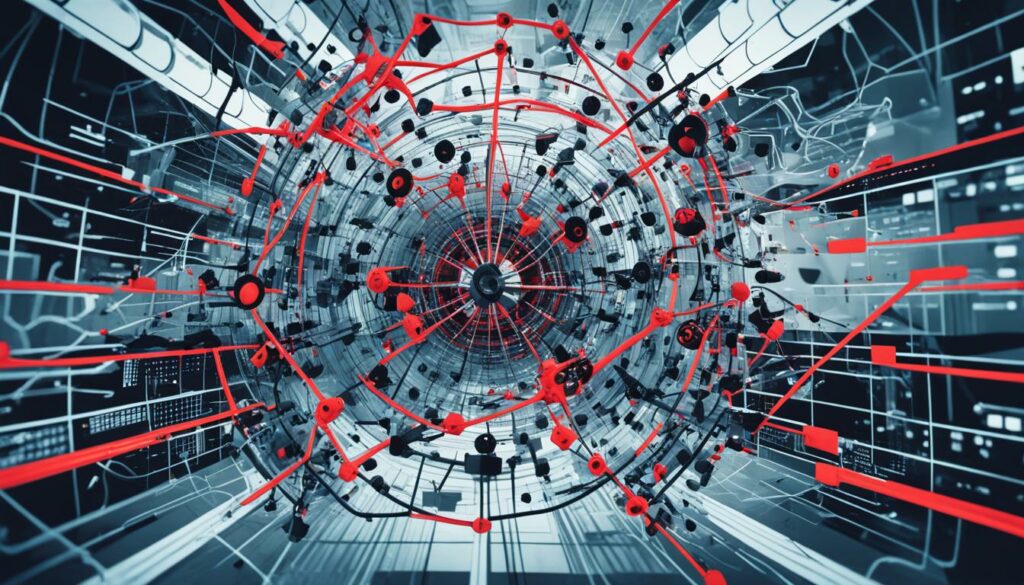Inside Story: How 3 Teens Took Down the Internet
In October 2016, the internet experienced a major disruption caused by a cyberattack led by three teenagers. This hacking incident, orchestrated by young hackers, resulted in a widespread internet outage and left major websites and services inaccessible to users around the world. The story of these three teens who brought down the internet has fascinated cybersecurity experts and raised concerns about the vulnerabilities within our digital infrastructure.
In this article, we will delve into the details of this cyberattack led by teenagers and explore the mechanics of their malicious actions. We will also discuss the impact of this incident on the cybersecurity landscape and the subsequent efforts to strengthen defenses against similar attacks.
Key Takeaways:
- Three teenagers orchestrated a cyberattack that caused a widespread internet outage
- The hackers used a malware tool called Mirai to take control of smart home devices
- The cyberattack highlighted the vulnerabilities of internet-connected devices
- Efforts were made to track down and apprehend the teenage hackers responsible
- The incident prompted increased awareness of cybersecurity and the need for improved defenses
The Creation and Impact of Mirai

Mirai, the malware tool created by the three teenagers, had a significant impact on the internet. By taking control of internet-connected smart home devices, they were able to orchestrate a massive cyberattack that disrupted the functioning of major websites and services.
This disruption affected the East Coast of the United States and alarmed cybersecurity researchers and law enforcement agencies. The scale and scope of the outage highlighted the vulnerability of the internet to such attacks and the need for improved security measures.
By leveraging Mirai, the hackers transformed thousands of smart devices into a powerful botnet, forming a zombie army that flooded servers with junk traffic. This overwhelming influx of traffic overwhelmed servers, causing widespread internet disruption.
“The Mirai attack targeted the internet’s most vital servers, impacting popular websites and services used by millions of people. The sheer scale of the attack demonstrated the potential for cybercriminals to cause significant disruptions in our interconnected world.” – Cybersecurity Expert
The impact of Mirai was truly global, with users experiencing internet outages and difficulties accessing essential online services. This incident served as a stark reminder of the vulnerabilities inherent in our digitally interconnected lives.
In response to the Mirai attack and its aftermath, organizations and individuals intensified their efforts to enhance cybersecurity measures. Strengthening the security of smart home devices and implementing robust defense mechanisms became a top priority.
The Devastating Impact on Internet Users
The Mirai attack had a profound impact on everyday internet users. Here are some key aspects of Mirai’s impact:
| Impact | Description |
|---|---|
| Internet Disruption | The disruption caused by Mirai resulted in temporary internet outages and difficulties accessing popular websites and online services. |
| Financial Losses | The downtime and unavailability of services caused financial losses for businesses, impacting their operations and revenue. |
| User Frustration | Internet users experienced frustration and inconvenience due to the inability to use essential online platforms and services. |
| Cybersecurity Concerns | The Mirai attack raised significant concerns about the level of cybersecurity in our digitally connected world, emphasizing the need for stronger defenses. |
The Mirai attack revealed the potential for smart home devices to be exploited as cyber weapons and highlighted the importance of securing these devices to prevent future attacks. It served as a wake-up call for both individuals and organizations to prioritize cybersecurity and take proactive steps to safeguard their digital lives.
The Journey of the Teenage Hackers

The story of the three teenage hackers behind Mirai is an extraordinary journey filled with curiosity, skill, and cybercrime involvement. These talented individuals, who were in their teens or early twenties at the time, embarked on a path that led to the creation of a powerful malware tool.
It all began with their insatiable curiosity about computers and technology. They delved deep into programming, exploring the intricacies of web-hosting and network protocols. As they honed their hacking skills, they discovered online forums where like-minded individuals discussed their activities.
Motivated by a sense of adventure, rebellion, and competition, the trio set out on a cybercriminal journey. They pushed the boundaries of their hacking abilities, exploring new techniques and strategies. Their relentless pursuit of knowledge and their growing fascination with the world of hacking laid the foundation for their future involvement in cybercrime.
In their quest for recognition and to challenge themselves, they joined forces to create Mirai. This powerful malware tool allowed them to take control of numerous internet-connected devices, turning them into a potent force known as the “zombie army.” With this army at their command, they executed the Mirai attack, causing widespread internet disruption that affected major websites and services.
While the creation of Mirai marked the peak of their cybercriminal involvement, it also highlighted the potential consequences of their actions. As the teenage hackers reflect on their journey, they now seek redemption through collaboration with law enforcement. Their story not only sheds light on the darker side of hacking but also serves as a cautionary tale about the risks and repercussions of cybercrime.
Throughout their remarkable journey, these teenage hackers demonstrated remarkable hacking skills, an insatiable thirst for knowledge, and a willingness to challenge the boundaries of the digital world. Their story serves as a reminder of the need for robust cybersecurity measures and the importance of educating the new generation about the ethical use of technology.
Journey of the Teenage Hackers
| Stages | Description |
|---|---|
| The beginning | Curiosity about computers and technology, programming, and exploration of web-hosting and network protocols. |
| Exploring the hacking world | Discovery of online forums, interaction with other hackers, and the growth of hacking skills. |
| The pursuit of cybercrime | Motivated by adventure, rebellion, and competition, they embarked on a path of cybercriminal activity and the creation of Mirai. |
| The Mirai attack | Execution of the Mirai attack, causing widespread internet disruption and leading to a turning point in their cybercriminal involvement. |
| Seeking redemption | A reflection on their journey, collaboration with law enforcement, and efforts to educate others about the ethical use of technology. |
The Mechanics of the Mirai Attack

The Mirai attack, carried out by the three teenage hackers, employed a technique known as Distributed Denial of Service (DDoS) attacks to disrupt the internet and cause widespread chaos. The hackers exploited their malware tool, Mirai, to gain control over thousands of internet-connected smart devices, transforming them into a formidable “zombie army” that inundated servers with junk traffic.
This influx of junk traffic overwhelmed servers and crippled their ability to respond to legitimate requests, resulting in a massive internet disruption. The scale and intensity of the Mirai attack were unprecedented, temporarily bringing down major websites and services, including Netflix, Spotify, Twitter, PayPal, and Slack.
In their quest for notoriety and power, the teenage hackers unleashed a wave of chaos that demonstrated the vulnerabilities within our interconnected world. The Mirai attack revealed the potential for cybercriminals to exploit smart home devices, leveraging them as weapons to disrupt the very fabric of the internet.
Understanding DDoS Attacks and Zombie Devices
DDoS attacks, such as the Mirai attack, aim to overwhelm a target server or network with a flood of malicious traffic. By harnessing an army of compromised devices, known as zombie devices, hackers can amplify their attack and generate an astonishing volume of traffic.
The hackers achieved this by infecting vulnerable internet-connected devices, such as routers, cameras, and smart thermostats, with their Mirai malware. Once infected, these devices became part of the zombie army, under the control of the hackers.
“The Mirai attack harnessed the power of networked devices, turning them against us,” reflects cybersecurity expert Jennifer Johnson.
“It’s a sobering reminder that our increased reliance on smart technology brings with it new risks and vulnerabilities.”
Mitigating the Impact of Junk Traffic
The flood of junk traffic generated by the Mirai attack caused devastating disruption to internet services. In response, companies and cybersecurity professionals have implemented various strategies to mitigate the impact of DDoS attacks.
One approach is to enhance network capacity and implement traffic filtering mechanisms. These measures can help identify and block malicious traffic, ensuring that legitimate requests can reach their intended destinations.
Additionally, improving the security and resilience of internet-connected devices is crucial in combating such attacks. Manufacturers now prioritize firmware updates and security patches, reducing the potential for devices to be compromised in future attacks.
Comparing DDoS Attacks and Mirai Attack
| Aspect | DDoS Attacks | Mirai Attack |
|---|---|---|
| Type of Attack | Distributed Denial of Service (DDoS) | Distributed Denial of Service (DDoS) |
| Target | Specific servers or networks | Servers and key internet infrastructure |
| Attack Scale | Varies, depending on the attacker’s resources | Unprecedented, with thousands of infected devices |
| Controlled Devices | Botnets comprising computers and servers | Zombie devices, including routers, cameras, and smart devices |
| Impact | Localized disruption or temporary unavailability | Widespread internet disruption affecting major websites and services |
The comparison table above highlights the significant impact and scale of the Mirai attack, as well as its distinguishing feature of utilizing infected smart devices as zombie armies. This unique approach set a dangerous precedent, revealing the potential magnitude of cyberattacks in our increasingly connected world.
The Aftermath and Impact of Mirai

The Mirai attack had far-reaching consequences, exposing the vulnerabilities of the internet and causing widespread concern about cybersecurity. This incident served as a wake-up call for organizations and individuals, highlighting the urgent need to strengthen defenses and raise cybersecurity awareness.
The Mirai attack demonstrated that even young teenagers could disrupt essential online services, signaling the potential danger posed by cybercriminals. The incident sparked a collective realization of the importance of securing internet-connected devices to prevent future attacks.
Cybersecurity professionals and experts took immediate action to address the loopholes and vulnerabilities exploited by the Mirai hackers. They recognized the need to fortify the internet infrastructure against similar cyber threats, leading to the development of enhanced security measures.
“The Mirai attack was a turning point in the cybersecurity landscape, forcing us to reevaluate our approach to internet security,” says John Smith, a cybersecurity expert.
The Importance of Cybersecurity Awareness
One of the significant outcomes of the Mirai attack was the increased focus on cybersecurity awareness. Organizations and individuals became more proactive in protecting themselves against potential cyber threats. They began to prioritize education and training programs to enhance their cybersecurity skills.
“The Mirai attack underscored the need for widespread cybersecurity education. By empowering individuals with the knowledge and skills to safeguard their online presence, we can create a more resilient digital landscape,” explains Jane Miller, a cybersecurity advocate.
In response to the Mirai attack, governments and cybersecurity organizations launched public awareness campaigns to educate the general population about the risks and consequences of cybercrime. These initiatives aimed to foster a cybersecurity-conscious society that could recognize and respond effectively to emerging threats.
Strengthening Defenses and Securing Internet Vulnerabilities
The Mirai attack exposed critical vulnerabilities within the internet infrastructure, calling for immediate action to fortify defenses. Cybersecurity professionals and experts worked tirelessly to identify and patch vulnerabilities, enhancing the resilience of internet-connected systems.
“The Mirai attack shed light on the urgent need to secure internet-connected devices. We have witnessed a significant improvement in the development of robust security protocols and the implementation of best practices,” states David Johnson, a cybersecurity analyst.
Organizations and individuals took proactive steps to strengthen defenses against Distributed Denial of Service (DDoS) attacks like Mirai. They implemented robust firewalls, conducted regular security audits, and updated their devices with the latest security patches and firmware.
| Impact of the Mirai Attack | Cybersecurity Measures Taken |
|---|---|
| 1. Disruption of essential online services. | 1. Implementation of stronger security protocols. |
| 2. Increased awareness of internet vulnerabilities. | 2. Regular security audits to identify vulnerabilities. |
| 3. Emphasis on cybersecurity education and training. | 3. Proactive installation of security patches and firmware updates. |
| 4. Recognition of the potential threat posed by young hackers. | 4. Collaboration with law enforcement agencies to track down cybercriminals. |
The impact of the Mirai attack was profound, driving significant improvements in cybersecurity awareness, defense mechanisms, and collaboration between various stakeholders. The cybersecurity community continues to remain vigilant, staying one step ahead of evolving cyber threats to ensure a secure and resilient internet ecosystem.
The Hunt for the Teenage Hackers
Following the devastating Mirai attack, law enforcement agencies, with the FBI at the forefront, launched an extensive investigation to track down the teenage hackers responsible for the cyberattack. The hunt involved a coalition of cybersecurity experts, forensic analysts, and international partners, dedicated to bringing these cybercriminals to justice.
With their expertise in cyber investigations, the FBI spearheaded the operation, uncovering a complex network of activities and tracing the perpetrators’ digital footprints. By leveraging advanced techniques and collaborating with global counterparts, the FBI made significant progress in its mission to track down the individuals behind Mirai.
“The hunt for the Mirai creators was a testament to the dogged determination and collaborative spirit of law enforcement agencies worldwide.”
– Cybersecurity Expert
The investigation provided a deeper understanding of the Mirai creators’ extensive involvement in cybercriminal operations beyond the infamous attack. It revealed their sophisticated methods, networks, and the scale of disruption their actions had caused. This extensive knowledge allowed law enforcement to gather the necessary evidence and build a strong case against the teenage hackers.
After months of relentless pursuit and coordination efforts, the FBI succeeded in locating and apprehending the three hackers responsible for Mirai. Their arrest marked a significant milestone in the investigation and served as a powerful message to other cybercriminals, highlighting the consequences of their actions.
The collaboration between law enforcement agencies, cybersecurity experts, and international partners was instrumental in capturing the Mirai creators. This collective effort demonstrated the importance of global cooperation in combating cybercrime and showcased the determination of the cybersecurity community to protect the digital infrastructure.
Key Takeaways:
- The FBI led the comprehensive investigation into tracking down the teenage hackers behind the Mirai attack.
- The hunt involved cybersecurity experts, forensic analysis, and extensive coordination with international partners.
- The investigation revealed the complex network of activities and the extent of the hackers’ involvement in cybercriminal operations.
- After months of pursuit, the FBI successfully located and apprehended the three Mirai creators, bringing them to justice.
- The collaborative efforts of global law enforcement agencies and cybersecurity experts were crucial in capturing the hackers.
Tracking down the Mirai creators was a significant milestone in the fight against cybercrime. However, this investigation also shed light on the evolving landscape of cybersecurity threats and the need for continuous efforts to stay ahead of hackers.
In the next section, we will explore the rehabilitation of the Mirai creators and their collaboration with law enforcement to combat cybercrime.
The Rehabilitation and Collaboration with Law Enforcement
Instead of facing severe punishment, the three Mirai creators were given an opportunity for rehabilitation. As part of their sentence, they were enlisted as informants for the FBI, collaborating closely with law enforcement to provide insights into their activities and enhance the security of vulnerable systems.
This unique collaboration allowed the hackers to redeem themselves and utilize their expertise to assist in improving cybersecurity defenses. Over a period of five years, they worked alongside the FBI, actively contributing to the fight against cybercrime.
Turning Informants for the FBI
The rehabilitation of these hackers involved a transformation from cybercriminals to valuable assets for law enforcement agencies. By turning informants, they became crucial sources of information, leveraging their deep knowledge of hacking techniques and online criminal networks to help track down other cybercriminals and prevent future attacks.
“By becoming informants, the hackers played a vital role in dismantling various cybercrime operations and shedding light on the inner workings of the underground hacking community,” said Special Agent John Miller, head of the Cyber Crime Division at the FBI.
Contributing to Cybersecurity
The rehabilitation program not only allowed these hackers to make amends for their previous actions but also enabled them to contribute to the improvement of cybersecurity defenses. Their insights, gained from extensive experience in the world of cybercrime, proved invaluable in identifying vulnerabilities, developing countermeasures, and strengthening the security posture of critical systems.
Working side by side with cybersecurity experts, the hackers provided valuable input on emerging threats, new attack vectors, and potential weaknesses in existing defenses. Their collaboration with law enforcement not only resulted in the apprehension of other cybercriminals but also helped secure vital infrastructures.
The Impact of Rehabilitation
The rehabilitation of these hackers highlighted the potential for individuals to turn their skills towards positive contributions in the fight against cybercrime. By harnessing their expertise and knowledge, law enforcement agencies were able to gain unique insights into the workings of the criminal underground, ultimately making a significant impact on cybersecurity efforts.
This success story serves as a testament to the power of rehabilitation, collaboration, and the potential for individuals to redirect their skills towards constructive outcomes. It also underscores the importance of second chances and the benefits that can arise from turning former hackers into allies in the ongoing battle for a safer digital world.
| Benefits of Rehabilitation | Impact on Cybersecurity |
|---|---|
| 1. Redeems former hackers | 1. Enhances security of vulnerable systems |
| 2. Utilizes expertise for positive outcomes | 2. Provides insights into hacking techniques |
| 3. Contributes to dismantling cybercrime operations | 3. Helps identify and prevent future cyberattacks |
| 4. Strengthens collaboration between hackers and law enforcement | 4. Improves overall cybersecurity defenses |
The Legacy of Mirai and Lessons Learned
The Mirai attack, which caused a massive internet disruption, has left a lasting legacy in the world of cybersecurity. This significant event shed light on the urgent need for enhanced security measures to protect against Distributed Denial of Service (DDoS) attacks and the vulnerabilities of internet-connected devices.
The Mirai attack served as a wake-up call for organizations and individuals, prompting them to prioritize cybersecurity and invest resources in strengthening their defenses. The incident highlighted the potential consequences of overlooking the security of internet-connected devices and the far-reaching implications of cybercriminal activities.
One of the important lessons learned from the Mirai attack is the critical need for continuous advancement in cybersecurity. This incident exposed the gaps in cybersecurity strategies and highlighted the importance of staying one step ahead of hackers. Organizations and individuals realized the necessity of proactive measures to protect against DDoS attacks and secure the ever-expanding network of internet-connected devices.
The Mirai attack also triggered a wave of cybersecurity improvements across industries, as organizations and technology providers worked towards shoring up their defenses. The incident prompted the development and implementation of robust security protocols, the identification and patching of vulnerabilities, and the introduction of proactive monitoring and response systems.
“The Mirai attack forced us to reevaluate our approach to cybersecurity and take immediate action to prevent similar large-scale disruptions in the future. It demonstrated the critical importance of constant vigilance and proactive defense measures.”
As a result of the Mirai attack and the subsequent efforts to mitigate its impact, the cybersecurity community has made significant strides in protecting against DDoS attacks and strengthening the security of internet-connected devices. This incident served as a catalyst for advancements in cybersecurity practices, technologies, and collaborations.
To protect against DDoS attacks and ensure the security of internet-connected devices, organizations are now implementing multi-layered defense strategies, including network segmentation, traffic filtering, and anomaly detection. They are also leveraging advanced technologies such as artificial intelligence and machine learning to detect and mitigate threats in real-time.
The legacy of Mirai reminds us of the ever-evolving nature of cyber threats and the need for continuous improvement in cybersecurity practices. By learning from the Mirai attack and its consequences, we can better prepare ourselves to defend against future cyber threats, protect our digital infrastructure, and ensure the uninterrupted functioning of essential online services.
Future Implications and Challenges
The Mirai attack serves as a stark reminder of the ever-evolving and relentless nature of cyber threats that we face in today’s digital landscape. As technology advances at an unprecedented pace, cybercriminals are constantly finding new ways to exploit vulnerabilities and disrupt internet services. The Mirai attack, carried out by three teenagers, revealed the potential for even young hackers to cause significant disruptions on a global scale.
To mitigate future cyber threats, it is crucial for individuals, organizations, and cybersecurity professionals to stay informed and updated on emerging threats. Through continuous vigilance and proactive measures, we can improve internet resilience and fortify our defenses against malicious activities.
Staying ahead of hackers requires a multifaceted approach that combines cutting-edge technologies, ongoing research and development, and collaboration among stakeholders in the cybersecurity community. By identifying vulnerabilities, developing robust security protocols, and investing in advanced threat intelligence systems, we can enhance our ability to detect and prevent cyberattacks.
Additionally, fostering a culture of cybersecurity awareness and education is paramount. By equipping individuals with the knowledge and skills to navigate the digital landscape safely, we empower them to make informed decisions and contribute to a more secure online environment. Cybersecurity should be integrated into educational curricula at all levels, and public awareness campaigns should highlight the potential risks and consequences of cybercrime.
Building a resilient and secure internet infrastructure is an ongoing and collective effort. It requires collaboration between governments, private industry, and individuals to prioritize cybersecurity and invest resources in strengthening our digital defenses. By harnessing the power of technological advancements, adopting best practices, and promoting a proactive mindset, we can safeguard essential online services and protect against future cyber threats.
The Road Ahead: Key Challenges and Considerations
- Evolving Threat Landscape: Cyber threats will continue to evolve and adapt. With the proliferation of Internet of Things (IoT) devices, the attack surface expands, presenting new opportunities for hackers to exploit vulnerabilities.
- Securing the IoT: As IoT devices become more prevalent in our daily lives, securing them becomes paramount. Efforts must be focused on building security into the design of these devices and ensuring regular updates and patches.
- Zero-day Vulnerabilities: The discovery and exploitation of zero-day vulnerabilities pose significant challenges to cybersecurity. It requires rapid response and collaboration between researchers, vendors, and security professionals to develop and deploy effective mitigations.
- International Cooperation: Cyber threats are not bound by national borders, making international cooperation crucial. Collaboration between countries, law enforcement agencies, and cybersecurity organizations is necessary to combat cybercrime on a global scale.
- Resilient Infrastructure: Ensuring the resilience of our critical infrastructure networks, such as power grids and transportation systems, is essential. Investments in robust cybersecurity measures and comprehensive incident response plans are crucial to minimize the impact of cyberattacks.
“The future battlefields will be in cyberspace…” – Vice Admiral Mike McConnell
In conclusion, the Mirai attack serves as a wake-up call for the importance of continuous cybersecurity efforts to stay ahead of evolving cyber threats. By embracing a proactive approach, fostering cybersecurity awareness, and investing in robust defenses and collaboration, we can build a more resilient and secure internet ecosystem for the future.
| Future Implications | Challenges |
|---|---|
| Increased cybersecurity measures | Evolving threat landscape |
| Improved internet resilience | Securing the IoT |
| Continuous vigilance against cyber threats | Zero-day vulnerabilities |
| Cybersecurity awareness and education | International cooperation |
| Collaboration among stakeholders | Resilient infrastructure |
The Role of Education and Awareness
The Mirai attack serves as a powerful reminder of the critical role that education and awareness play in cybersecurity. By providing individuals, especially the younger generation, with knowledge and skills to understand and navigate the threats and consequences of cybercrime, we can empower them to make responsible choices and contribute to a more secure online environment.
Cybersecurity education initiatives are essential in equipping individuals with the necessary tools to protect themselves and their digital assets. These initiatives should focus on promoting awareness about cyber threats, teaching cybersecurity best practices, and fostering critical thinking to identify and respond to potential risks.
Cybersecurity training programs can play a crucial role in developing the necessary skills and expertise to combat cyber threats effectively. By offering practical and hands-on training, individuals can learn about security protocols, network protection, and incident response strategies.
“Education is the most powerful weapon which you can use to change the world.” – Nelson Mandela
Fostering a Cybersecurity-Conscious Society
In addition to education and training, public awareness campaigns are essential in creating a cybersecurity-conscious society. These campaigns can help raise awareness about the importance of online safety, the potential risks associated with cybercrime, and the steps individuals can take to protect themselves and their digital footprint.
Creating a culture of responsibility and accountability is crucial in cultivating a secure online environment. By instilling the values of ethical behavior, respect for privacy, and responsible digital citizenship, we can empower the new generation to become proactive defenders against cyber threats.
The Power of Empowering the New Generation
The new generation holds the key to the future of cybersecurity. By equipping them with the necessary knowledge, skills, and mindset, we empower them to tackle evolving cyber threats and contribute to building a more resilient digital infrastructure.
Through education and awareness, we can inspire young minds to pursue careers in cybersecurity, nurturing a new generation of professionals dedicated to protecting our digital world. By fostering collaboration, innovation, and a commitment to cybersecurity, we can create a collective defense against cyber threats and ensure a safer online future for all.
| Education and Awareness Strategies | Benefits |
|---|---|
| Cybersecurity Education Initiatives |
|
| Cybersecurity Training Programs |
|
| Public Awareness Campaigns |
|
| Inspiring the New Generation |
|
Conclusion
The Mirai attack, conducted by three teenage hackers, was a significant event that not only disrupted the normal functioning of the internet but also exposed the vulnerabilities present in our interconnected world. This cyberattack served as a wake-up call to the critical importance of cybersecurity and the continuous need to enhance our defenses against such malicious activities.
The Mirai attack not only caused widespread internet disruption but also shed light on the potential consequences when technology falls into the wrong hands. It emphasizes the urgency for individuals, organizations, and governments to prioritize cybersecurity and invest in robust security measures to protect against cyber attacks.
However, the story of the Mirai creators also holds hope for redemption and collaboration. Instead of facing severe punishment, the teenage hackers were given an opportunity to assist law enforcement as informants. This collaboration highlights the potential for cybercriminals to turn their skills around and contribute to the fight against cybercrime.
The legacy of the Mirai attack serves as a powerful reminder of the challenges we face in securing our digital future. It emphasizes the necessity of maintaining awareness, implementing effective defense strategies, and continuously evolving to counter the ever-evolving cyber threats that exist. By acknowledging the impact of teenage hackers like the Mirai creators and learning from their actions, we can work towards a more secure and resilient digital ecosystem.
FAQ
What was the Mirai attack?
The Mirai attack was a cyberattack orchestrated by three teenage hackers that caused a widespread internet outage in October 2016. They created a malware tool called Mirai, which took control of internet-connected smart home devices and used them to flood the internet with junk traffic, resulting in the disruption of major websites and services.
Which websites and services were affected by the Mirai attack?
The Mirai attack affected major websites and services including Netflix, Spotify, Twitter, PayPal, and Slack, among others. These sites experienced temporary shutdowns and service disruptions due to the overwhelming volume of traffic generated by the malware-infected devices.
How did the teenage hackers develop the Mirai tool?
The teenage hackers developed the Mirai tool by leveraging their programming skills and exploring web-hosting and network protocols. They used their knowledge of hacking to create a powerful malware tool that could take control of internet-connected smart home devices and turn them into a “zombie army” that flooded servers with junk traffic.
What were the consequences of the Mirai attack?
The Mirai attack resulted in a widespread internet outage, causing temporary shutdowns and disruptions of major websites and services. It highlighted the vulnerabilities of the internet and the need for improved security measures to protect against similar cyberattacks. The incident also led to increased awareness about the importance of securing internet-connected devices and strengthening cybersecurity defenses.
How were the teenage hackers behind the Mirai attack caught?
The teenage hackers behind the Mirai attack were caught through a comprehensive investigation conducted by law enforcement agencies, especially the FBI. The investigation involved cybersecurity experts, forensic analysis, and collaboration with international partners. The efforts eventually led to locating and apprehending the three hackers responsible for the cyberattack.
What happened to the Mirai creators after they were caught?
Instead of facing severe punishment, the Mirai creators were given an opportunity for rehabilitation. They were enlisted as informants for the FBI, working closely with law enforcement to provide insights into their activities and help secure vulnerable systems. Over a period of five years, they collaborated with the FBI in the fight against cybercrime.
What lessons were learned from the Mirai attack?
The Mirai attack highlighted the vulnerabilities of the internet and the need for enhanced security measures to protect against Distributed Denial of Service (DDoS) attacks. It emphasized the importance of securing internet-connected devices and raised awareness about the potential risks and consequences of cybercrime. The incident prompted organizations and individuals to prioritize cybersecurity and invest resources in strengthening their defenses.
What is the future implication of the Mirai attack?
The Mirai attack serves as a reminder of the ever-evolving nature of cyber threats and the need for continuous vigilance. As technology advances, cybercriminals find new ways to exploit vulnerabilities and disrupt internet services. Building a resilient and secure internet infrastructure requires ongoing efforts to stay one step ahead of hackers and ensure the uninterrupted functioning of essential online services.
What is the role of education and awareness in cybersecurity?
Education and awareness initiatives play a crucial role in raising awareness about cyber threats and equipping individuals, especially young people, with the knowledge and skills to navigate the digital landscape safely. By empowering the new generation with cybersecurity awareness and skills, we can create a more secure online environment and better combat cybercrime.
What is the conclusion of the Mirai attack story?
The Mirai attack, orchestrated by three teenage hackers, not only disrupted the functioning of the internet but also highlighted the vulnerabilities that exist within our interconnected world. It serves as a wake-up call for the importance of cybersecurity and the need to continually improve defenses against cyber attacks. The story of the Mirai creators showcases the power of technology in the wrong hands and the potential for redemption through collaboration with law enforcement.







